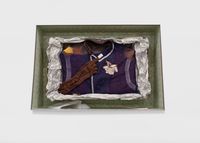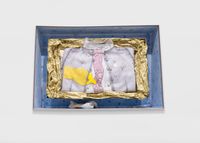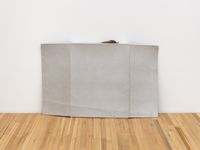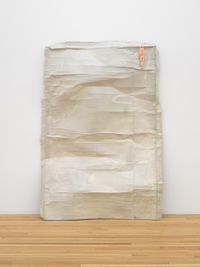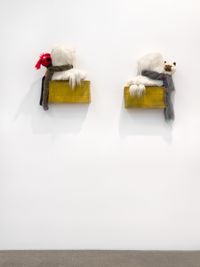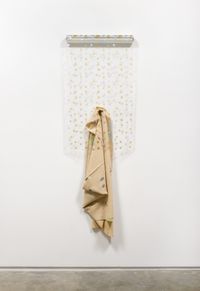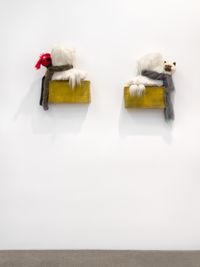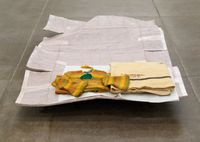As Canada's representative at the 1984 Venice Biennale, Liz Magor's work across sculpture, photography and installation has explored the nature and emotional undertones of familiar objects as receptacles of identity, histories and desire for over four decades.
Read MoreOne of five children, Liz Magor was born in 1948 in Winnipeg, Manitoba, and grew up in Prince Rupert, British Columbia, where her family relocated in the early 1950s. As a child, Magor recalls being an avid reader, fascinated by stories, materials and object construction.
Merging her interests, Magor studied Fine Arts at the University of British Columbia (1966–1968), before moving to New York to attend the Parsons School of Design (1968–1970). She returned to Vancouver in 1970 to complete her training at the Vancouver School of Art (presently the Emily Carr University of Art + Design).
Liz Magor's sculptures and installations often comprise delicate casts of commonplace objects combined with found ephemera and 'guilty pleasure' items to highlight the human desires that motivate systems of production and the consequences such systems have.
After graduation, Magor stayed on Vancouver's West Coast to research the varied terrains of British Columbia. Influenced by this proximity to natural ecosystems, early sculptures explored systems of production and reproduction, often transposing assemblages of natural and man-made materials into the gallery, only, modified to resemble consumer objects.
The first, Bird Nest Kits (1975) comprised four stacks of cardboard boxes containing found bird nests, each whimsically labelled like merchandise. Birdnester (1977) featured a similar display, this time, with rugged nests filling the compartments of a wooden wagon.
The later Compost Figures (1978), with its large wooden slabs modelled after the human figure, opened a similar line of inquiry. Mummified in webs of cotton, they faced the ceiling like sarcophagus, implicating the artwork within cycles of mechanical production and decay.
After moving to Toronto in 1981, Magor's work shifted away from the natural world to contend with the social and emotional lives of objects. She found great success that decade, showing at the Biennale of Sydney (1982), the Venice Biennale (1984) and documenta 8 (1987).
Among the sculptures and installations that fuelled her acclaim is Dorothy, A Resemblance (1980–1981). A woman's story is told across four steel tables, each supporting an assortment of commonplace items — books, candles, matches, bread — cast in lead.
Grouped to represent Dorothy's body weight at different stages of her life, they explored the idea of weight as a stand-in for Dorothy – an investigation that continued in the works The Most She Weighed/The Least She Weighed (1982) and I Have Always Weighed 98 Pounds (1983–1984).
In the 1980s, Magor released the 'Field Work' photography series (1989): black-and-white images of herself and friends taken in the 1960s, when the back-to-the-land hippy movement incited mass migration away from urban centres.
Shot camping, fishing and inhabiting the wilderness in headdresses and moccasins, the work, intended to be an ode to the delusions of youth, was deemed as cultural appropriation. Taken by such critiques, Magor left Toronto shortly after.
Always with storytelling in mind, Magor's installations grew in scope and scale over time, eventually filling entire galleries with moulded and hand-cast replicas of household items that prompted a closer look at the objects that populate our daily lives.
Recalling past and pending disasters, the life-size log cabin Messenger, first installed at Toronto's Sculpture Garden, comprised a small bunker furnished with a cot, a wooden stove, fuel, non-perishable rations and ammunition.
Scattered and piled around the room, its material curiosities invited further inquiry as to the physical presences the space once sheltered. In 2002, the structure was moved to Vancouver Art Gallery for the artist's mid-career survey exhibition.
Piled inside a storage room are the contents of One Bedroom Apartment (1996)—boxes on boxes, a lone mattress, disassembled furniture, scattered wall decor and books all around: the belongings of a person mid-move.
Reflecting the anxiety of displacement, subsequent versions have incorporated different objects, borrowed and rented. The only constant: the sculpture of a dog under a table peering up.
More recently, garments used and damaged, often with historical significance, entered Magor's repertoire of 'serviceable' items – service trays, tables, and cardboard boxes. Combined with found ephemera and small vices, they unveil the emotional undertones associated with familiar objects and the destruction brought on by consumer society.
As the artist has said, 'Art is the place where our perceptions are opened and examined for prolonged periods of time.' A decaying present thus materialises across bright Toblerone bars wrapped in emergency blankets (Tweed (Toblerone), 2008); leather mittens crammed with cigarettes (Humidor, 2004); casts of severed animal heads beside Jägermeister bottles; and silver-lined trays serving mouse corpses (Little Mouse Tray, 2009).
Bearing the inscriptions of past events, Perennial (2021) displays a black coat worn by 1960s and 70s student protestors. Magor does not mend, but marks the damaged parts with paint, adding two gypsum-cast cookies to its pockets as an ode to its prior existence.
Liz Magor is the recipient of many awards including the Chevalier d'Ordre des Arts et des Lettres, France (2021), the Gershon Iskowitz Prize, Art Gallery of Ontario (2015), the Audain Prize (2009), and the Governor General Award, Canada (2001).
In addition to the 1984 Venice Biennale and documenta 8, Liz Magor's work has been shown widely in solo and group exhibitions across North America, Europe and the U.K.
Select solo exhibitions include: Focal Point Gallery, Southend-on-Sea (2023); Andrew Kreps Gallery, New York (2021); Esker Foundation, Calgary (2020); Carpenter Center for the Arts, Cambridge, United States; The Renaissance Society, Chicago (2019); Kunstverein, Hamburg; Migros Museum für Gegenwartskunst, Zürich (2017); and Musée d'art contemporain de Montréal (2016).
Selected group exhibitions include: Catriona Jeffries, Vancouver (2020); Perrotin, Paris (2020); Musée d'art Moderne de la Ville de Paris (2019); Kunsthalle Basel (2017); National Gallery of Canada, Ottawa (2017); DePaul Art Museum, Chicago (2016); Museum of Contemporary Art Australia, Sydney (1996); and Stedelijk Museum, Amsterdam (1995).
Liz Magor is represented by Andrew Kreps Gallery, New York, and Catriona Jeffries, Vancouver.
Currently, she lives and works in Vancouver, Canada.
Elaine YJ Zheng | Ocula | 2023
